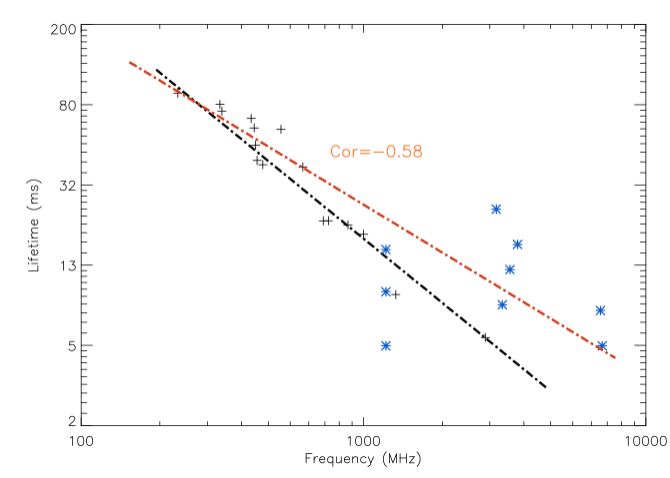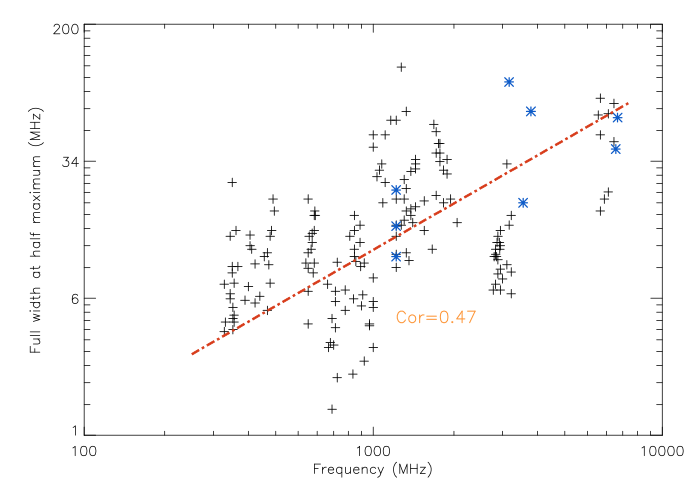Radio observation is one of the most important methods in solar physics and space science. Sometimes, it is almost the sole approach to observing physical processes such as the acceleration, emission, and propagation of non-thermal energetic particles, etc. Long-term observation and study have revealed that a strong solar radio burst is always composed of many small bursts with different time-scales. Among them, a radio spike burst is the smallest one, with the shortest lifetime, narrowest bandwidth, and smallest source region. Solar radio spikes are considered to be related to a single magnetic energy release process, and can be regarded as an elementary burst in solar flares. It is a basic requirement for new solar radio telescopes to observe and discriminate these solar radio spike bursts, even though their temporal and spatial scales actually vary with the observing frequency. Here, we presents the scaling laws of the lifetime and bandwidth of solar radio spike bursts with respect to the observing frequency, which provide some constraints for the next generation of solar radio telescopes, and help us to select the rational telescope observing parameters. As well as this, we propose a spectrum-image combination mode as the best observation mode for new solar radio telescopes with high temporal, spectral, and spatial resolutions, which may have an important significance for revealing the physical essence of the various non-thermal processes in violent solar eruptions.
Solar radio observation is the most important approach for obtaining information about solar energetic particles, violent energy release, and mass ejections in solar eruptions. Solar radio telescopes include solar radiometers, radiospectrometers, and radioheliographs with various frequency bandwidth, cadence, spectral and spatial resolutions. Based on new scientific assumptions and technical development, new plans of solar radio telescopes are continuously proposed. In the development of new generation solar radio telescopes, it is very important to select a set of suitable observing parameters, such as frequency range, bandwidth, cadence, spectral resolution, and spatial resolution, etc. So, how does one select a reasonable group of observing parameters of a proposed solar radio telescope?
Previous statistical studies indicate that a solar eruption lasting several tens of minutes always contains several big pulses with timescales of minutes, and each big pulse is frequently composed of a group of pulses with timescales of seconds, and each pulse is still composed of many sub-pulses with timescales of sub-seconds. Actually, a violent solar eruption always contains a great number of sub-second radio bursts, which are called fast fine spectral structures (FFS). FFS includes spike bursts, dot bursts, and narrow-band type III bursts. In the microwave range, they are called small-scale microwave bursts (SMB) (Tan 2013). They have a very short lifetime, very narrow frequency band, and very high brightness temperature. They always occur in large groups and form various kinds of complex structures, such as QPPs, Zebra patterns, and other long-lasting pulses. Each SMB may represent an elementary energy release process, which can be regarded as the elementary burst (EB) in solar eruptions. Therefore, it becomes the basic requirement to identify clearly SMBs for the new generation of solar radio telescopes.
This work investigated the previous observational results of solar radio spike bursts, dot bursts, and narrowband type III bursts, including the previous publications (Gudel & Benz 1990, Rozhansky et al. 2008, etc.), and tried to obtain a modified scaling law of solar SMBs. Such a modified scaling law will be the theoretical basis to select reasonable parameters for designing the new generation of solar radio telescopes, and help us understand the nature of solar eruptions.
Figure 1 presents the statistical relationship between the averaged lifetime and frequency among solar radio spike bursts. The frequency range covers from 210 MHz to 7.0 GHz, and the lifetime ranges from 5 ms to 91 ms. It shows that the averaged lifetime of radio spike bursts is anti-correlated to the emission frequency, the correlation coefficient is -0.58. A fitted function is near a power-law function:
\[ \tau \approx 8.2 \times 10^3 f^{-0.84\pm0.15} \]
is the averaged lifetime of SMB in units of ms, $f$ is the frequency in units of MHz.
 Figure 1 – The relationship between the averaged lifetime and frequency among the solar radio spike bursts. Here, the crosses represent the results published in Gudel & Benz 1990 and Rozhansky et al. 2008 and the dashed line is obtained by least squared fitting method. The diamonds represent the results observed by the Chinese Solar Broadband Radio Spectrometers at Huairou (SBRS/Huairou) since 2006 (Wang et al. 2008, Tan 2013) and the solid line is obtained by least squared fitting method over the total sample.
Figure 1 – The relationship between the averaged lifetime and frequency among the solar radio spike bursts. Here, the crosses represent the results published in Gudel & Benz 1990 and Rozhansky et al. 2008 and the dashed line is obtained by least squared fitting method. The diamonds represent the results observed by the Chinese Solar Broadband Radio Spectrometers at Huairou (SBRS/Huairou) since 2006 (Wang et al. 2008, Tan 2013) and the solid line is obtained by least squared fitting method over the total sample.
Figure 2 presents the relationship between the averaged bandwidth and frequency among the solar radio spike bursts. The observing frequencies of the whole sample range from 305 MHz to 7.0 GHz. The narrowest bandwidth is 1.4 MHz at central frequency of 710 MHz, while the widest bandwidth is 115 MHz at 1250 MHz. We found that the higher the observing frequency, the wider the bandwidth of SMB. The statistical correlation coefficient between the bandwidth and the central frequency is 0.47 among the 166 samples, which is obviously positive correlation. A fitting function is also obtained:
\[ f_{bw}\approx 0.011 \times f^{0.99\pm0.018}\sim 1.1\% f \]
Here, $f_{bw}$ is the averaged bandwidth of SMB in unit of MHz.
 Figure 2 – The relationship between the averaged bandwidth and frequency among the solar radio spike bursts. Here, the crosses represent the results published in Gudel & Benz 1990 and Rozhansky et al. 2008. The diamonds represent the results observed by the Chinese Solar Broadband Radio Spectrometers at Huairou (SBRS/Huairou) since 2006 (Wang et al. 2008, Tan 2013) and the dot-dashed line is obtained by least squared fitting method over the total sample.
Figure 2 – The relationship between the averaged bandwidth and frequency among the solar radio spike bursts. Here, the crosses represent the results published in Gudel & Benz 1990 and Rozhansky et al. 2008. The diamonds represent the results observed by the Chinese Solar Broadband Radio Spectrometers at Huairou (SBRS/Huairou) since 2006 (Wang et al. 2008, Tan 2013) and the dot-dashed line is obtained by least squared fitting method over the total sample.
Because SMBs, including spike, dot, and narrow band type III bursts are the smallest eruptive units in solar eruptions, their scaling laws may provide a most important and fundamental basis for understanding the nature of solar eruptions and for the designing of the next generation solar radio telescopes.
Conclusions
For the studies of solar radio astronomy, we always hope that the telescope has high parameters configuration as soon as possible, such as high sensitivity, high resolutions, and broad frequency coverage. However, one high parameter is always at the cost of decrement of other parameters. For example, the high frequency resolution inevitably means the frequency bandwidth of individual channel becomes narrow, and this will decrease the sensitivity. When the time resolution increases, the integration time will become short which will cause the sensitivity decrease and make the relatively weak burst to be vague and submerged in noise. The scaling laws of SMB show that the time scale of the detailed variation in solar radio bursts decreases with the increase of frequency, and the bandwidth increases with the increase of frequency. The scaling laws may help us to determine the optimal parameters configuration of the new generation solar radio telescopes, so as to ensure the scientific output from the observed data to the greatest extent. For the imaging observation, if we select too high time and frequency resolutions, it will not only face to a great challenge in techniques, but also inevitably reduce the observational sensitivity, and sacrifice the scientific objective of the relevant telescope. Therefore, we propose the spectrum-image combination mode to observe the solar radio eruptions on the basis of the scaling laws of radio spike emission, it can realize the observation simultaneously with high temporal, spatial, and spectral resolutions, as well as a high sensitivity, and can be taken as the principal mode for the future new generation solar radio observations, it will have broad prospects for the relevant studies. However, the high parameters here are relative, they will be gradually upgraded with the new development of radio and computer techniques.
Based on a recently published paper: Tan, Bao-lin, Cheng, Jun, Tan Cheng-ming, Kou, Hong-xiang, ChA&A, 2019, 43, 59-74, doi: 10.1016/j.chinastron.2019.02.005
References:
Guedel, M., Benz, A. O.: 1990, A&A, 231, 202
Rozhansky, I. V., Fleishman, G. D., Huang, G.-L.: 2008, ApJ, 681, 1688
Tan, B.L.: 2013, ApJ, 773, 165
Tan, B. L., Cheng, J., Tan, C. M., Kou, H. X.: 2019, ChA&A, 43, 59
Wang, S. J., Yan, Y. H., Liu, Y. Y., Fu, Q. J., Tan, B. L., Zhang, Y.: 2008, SoPh, 253, 133
